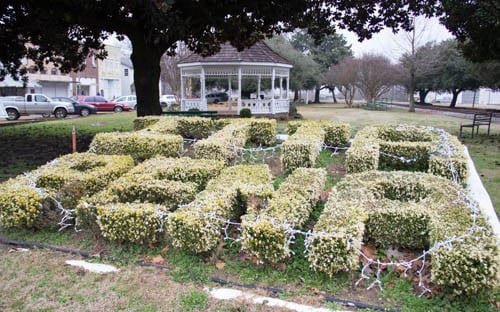

Last month, Jerome Powell, who is chairman of the Federal Reserve, came to Itta Bena, Mississippi, a small town of 1,828 people, an estimated 93.3 percent of whom are black, and home to Mississippi Valley State University, a historically black college. It is a community that is suffering economically. Howard Schneider, writing for Reuters, notes that, in a town located near “the birthplace of blues legend B.B. King, Itta Bena’s main street today is largely shuttered.” Schneider adds that the median income in surrounding Leflore County “at around $23,600, is the 23rd-lowest in the nation and less than a fourth of what it is in Powell’s childhood and current hometown of Montgomery County, Maryland.” Powell was clearly far away from his normal abodes of Wall Street and Washington, DC.
At the conference, Powell acknowledged that, “Poverty remains a challenge in many rural communities. Indeed, 70 percent of the 473 ‘persistent poverty’ counties [defined as counties that have reported 20 percent poverty or higher in the last three census decades] in the United States are rural. Unemployment and mortality rates remain high in these communities. Along with lower incomes and wealth, the rate of business start-ups in these areas is lower. And their residents have less access to financial services. Many of these disparities have existed for generations, and in some places have roots in a history of discrimination.”
What brought Powell to Itta Bena? The answer is a community development financial institution, or CDFI. At the Summit, Powell lauded the work of the host CDFI, Hope Credit Union (officially Hope Enterprise Corporation) and praised a partnership in the Delta town of DeWitt, Arkansas (population 3,166) that had developed “between a community college, a university, the local government, farmers and restaurants, and a Community Development Financial Institution,” which has “led to the creation of several new businesses and imbued the town with a new sense of what is possible.”
The fact that the Fed chair would travel to a conference in rural Mississippi organized by a local CDFI speaks to the tremendous growth by CDFIs, both in the Delta and nationwide. Opportunity Finance Network, a national CDFI trade association network, issued a 20-year longitudinal study that found that while in 1995, assets under management community development banks was $926 million and $150 million for community development credit unions, by 2015 those numbers had changed to $35 billion and $55 billion, respectively. In other words, the size of the industry had increased more than 80-fold.
The CDFI industry began as an initiative supported by President Bill Clinton. At the time the CDFI Fund was established, it was hoped that federal support might lead to a network of 100 banks with a total of $10 billion in assets. CDFIs have far exceeded that goal. And growth has continued. A 2018 study that looked at all CDFIs—including not only banks and credit unions, but also loan and venture funds, found that assets for CDFIs as a whole totaled $185 billion (with banks and credit unions alone being responsible for over $160 billion of that amount).
Hope is celebrating its 25th anniversary this year. The organization began in 1994 as a community loan fund called Enterprise Corporation of the Delta (ECD). Bill Bynum, who had been one of the first employees at Self-Help Credit Union, now a leading CDFI nationally with over $2 billion in assets, had been recruited from North Carolina by regional leaders—including Rob Walton, the son of Sam Walton; Edwin Lupberger, then CEO of Entergy, and William Winter, a former Governor of Mississippi. With $1.5 million from Pew Charitable Funds and $4.5 million in matching funds from the Waltons, Entergy, and various other foundations such as Mott and Ford, the loan fund began with a modest $6 million.
Bynum explains that demand for loans almost immediately exceeded the supply of funds:
We soon saw that was a great deal of viable demand. People just needed the tools. Our job was bringing the tools there. We knew we had to scale up. We approached banks and banks told us they couldn’t provide grant support, but if we created an investment vehicle, we could do better.
To deal with the shortfall, Bynum and his staff got a private action letter from the IRS to create limited liability corporations (LLCs) that allowed banks to make investments into the loan fund. “Today, nonprofits across the country use LLCs,” Bynum points out. The LLC structure enabled the fledgling CDFI to raise capital from banks, leveraging the Community Reinvestment Act, which says that banks have an “affirmative obligation” to make credit available in low-income communities.
Adding the credit union was the next piece of the puzzle—and, it happened in a way that was nothing if not unconventional. Bynum explains that, “I had actually started a credit union at my church as a volunteer project. My day job was ECD. My church chartered the first credit union chartered in state of Mississippi in eight years. Over a period of 25 years that I have lived here, there has been one credit union chartered in the state and it was Hope.”
And then the loan fund and the credit union were merged, as Bynum explains:
So, we had organized a credit union. We were excited about having that vehicle, but we could only go so far with volunteer support. ECD had a viable demand, but limited bank and philanthropic support. In 2002, ECD became the sponsor of the credit union. Now the credit union has professional staff. And ECD had the ability to use deposits to provide liquidity for our lending.
It is not surprising that the “Hope” name, far catchier than Enterprise Corporation of the Delta, is now featured. Hope Enterprise Corporation is actually a set of three nonprofit organizations—the credit union, the original loan fund, and a policy arm.
Sign up for our free newsletters
Subscribe to NPQ's newsletters to have our top stories delivered directly to your inbox.
By signing up, you agree to our privacy policy and terms of use, and to receive messages from NPQ and our partners.
Hope expanded further when the CDFI accessed a then-new program in 2004 called New Markets Tax Credits, which give taxpayers (typically banks) a reduction in their tax burden in exchange for investing in low-income areas. And then came hurricane Katrina, which, as Bynum details, led to an intense demand for services:
In August 2005, Hurricane Katrina hit the coast and we found ourselves in the middle of the recovery effort. You had to have a bank account to get FEMA payments. We made thousands of recovery loans. We helped design a program for 10,000 to access $600 million in federal support in Mississippi. We went from 55 to 150 employees. In the process, we built significant project management capabilities that we are using to this day.
For a short while in the post-Katrina period, Hope was the “fastest growing credit union in the country by membership and rate of asset growth,” Bynum notes. Mergers, particularly after the Great Recession, has led to further expansion. Today, the credit union has 30 branches, close to 48,000 member-owners, and nearly $400 million in assets.
Hope is not the only large CDFI in the region. Another prominent CDFI in the region—and a cosponsor of the forum that brought the Fed chair to Mississippi—is Southern Bancorp. Like Hope, Southern began small, with $10 million in assets, notes bank CEO Darrin Williams, and has grown through a combination of internal growth and acquisitions since. Total assets today, according to the bank’s 2017 annual report, exceed $1.2 billion.
Unlike Bynum, who grew up in community development finance, Williams did not. Williams says he was first exposed to CDFIs when he was in a first-year representative in the Arkansas state legislature. “I just called them up,” Williams explains. Williams was aware they lent to low-income communities, but he knew little about the nuts-and-bolts of community finance.
Williams, “the son of a minister and a teacher,” says he “was adopted as an infant by people who were grandparents. When my dad died when I was in ninth grade, my mom taught in segregated schools. She was super-educated, but she didn’t handle money. I recognized she was being taken advantage of.” Williams adds that what brought him to Southern was “truly the mission. It was not my experience in banking,” he notes.
“Our theory of change,” Williams explains, “depends on building assets. We know poverty is generational.” The bank over the next 10 years, has three primary goals—1) finance affordable home ownership for at least 10,000 people, 2) provide small business loans that support employment for at least 100,000 people, and 3) help a million people to save.
“We want to empower one million people to save,” Williams explains. “That is not just through customers, but policy changes.” Williams notes that welfare recipients who have more than $2,000 in assets in Arkansas lose their benefits. “We think that makes no sense. You can never get out of poverty if you don’t get assets.”
In short, both in terms of past growth and future goals, CDFIs have shown impressive scaling capacity. Yet despite gains, the challenges ahead remain large. As Bynum explains:
We are in a part of the country that is home of one third of the counties that are classified as persistent poverty counties—meaning over 20 percent poverty for three decades in a row. We are talking about deep-rooted entrenched poverty. These communities have the worst outcomes in terms of education, health, jobs, high-cost lending, and the number of people who are unbanked. They are also communities that have the highest concentration of African Americans.… We are fighting against long-term poverty and the legacy of racism, which is almost as deep today as in the 1960s when Dr. Martin Luther King was shifting his focus from voting rights to economic rights and encouraging folks to move their deposits to the black bank in Memphis.…We are still dealing with those issues today.
One reason for the continuing challenges is the demise of the traditional small banking sector. One study found that the share of bank assets nationally held by small banks had fallen from 30.1 percent of total bank assets in 2000 to 18 percent in 2014. Powell himself points out that, “industry consolidation has led to a long-term decline in the number of community banks. While most rural communities continue to be relatively well served, that is less often the case in communities with high-poverty rates.” Powell adds that, “In 2018, Federal Reserve staff members met with leaders in rural areas across the country that had recently experienced a bank branch closure. We found that small businesses, older people, and people with limited access to transportation are most affected. We also learned that the loss of the branch often meant more than the loss of access to financial services; it also meant the loss of financial advice, local civic leadership, and an institution that brought needed customers to nearby businesses.”
Changing those patterns, notes Bynum, requires changes that extend far beyond greater lending by CDFIs. “I don’t think that a CDFI is doing its job if it is not also advocating for systems change,” Bynum explains. “We are not ever going to be large enough to serve all of the needs of communities that are underserved facing require. I see it largely as R&D for financial policy, for social policy, for economic policy. We take that very seriously. We mine data from the work that we do, the communities where we have a presence, and take the information to have conversations to shape policies and practices to elected officials at the local, state, and federal level, and with banks.”
Bynum adds that, “People in Washington and money centers are oblivious to what is going on in communities of color and rural areas and places like the Delta.” Bringing the Federal Reserve chair to Mississippi—the first official Fed visit ever—is part of the effort of Delta-based CDFIs to break that isolation down. “We reached out to [Powell],” notes Bynum, “and asked him to come to this part of the country and let people hear from an influential decision maker. Let them know that all people matter…and give him an opportunity to hear from them.”











